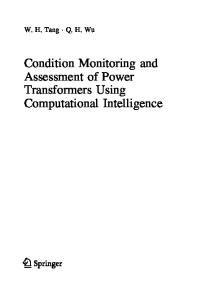The Reactivity of the Corrosion Mechanism in Transformers: A Computational Study
- PDF / 2,524,435 Bytes
- 14 Pages / 595.276 x 790.866 pts Page_size
- 42 Downloads / 291 Views
The Reactivity of the Corrosion Mechanism in Transformers: A Computational Study Sharlene‑Asia Naicker1 · Mervlyn Moodley1 Received: 14 June 2020 / Revised: 28 July 2020 / Accepted: 20 August 2020 © Springer Nature Switzerland AG 2020
Abstract Density functional theory (DFT) and Monte Carlo (MC) techniques were used to investigate the adsorption behaviour of sulphur-containing molecules namely dibenzyl disulphide (DBDS) and copper sulphide ( Cu2S) on different copper (Cu) surfaces. These sulphides are involved in the corrosion of copper windings in power transformers. The structural and quantum chemical parameters such as the molecular orbital energies, energy gaps and chemical hardness of these sulphides were investigated along with its electronic and energetic properties. To allow successful adsorption, the initial lattice parameters were determined prior to geometry optimization of all molecules and surfaces. The lowest adsorption energy configurations with its corresponding adsorption and deformation energies were determined. The density of adsorption sites were also determined. An adsorption energy comparison was done between the DBDS and Cu2S to determine the most reactive species on the different Cu surfaces. The reactivity of the two sulphides were investigated to provide a better understanding of the corrosion mechanism in transformers. The average bond distance between the sulphur (S) atom and the nearest Cu surface atom for the lowest energy configurations for both DBDS and Cu2S were compared in order to understand the behaviour of the sulphides. Keywords Copper corrosion · Transformer corrosion · Dibenzyl disulphide · Density functional theory · Adsorption locator · Monte Carlo
1 Introduction The efficient running of power transformers is of worldwide concern after a significant number of transformers were found to be failing without warning [1]. These failures have put increased stress on the financial, social and economic sectors of the power industry. Transformer failures have been attributed to corrosive sulphur that has been found to react with the Cu surfaces [1–3]. One species of corrosive sulphur has been identified as dibenzyl disulphide (DBDS). The product of the reaction of DBDS ((C6 H5 CH2 )2 S2 ) with a Cu surface results in Cu2S as a first mechanism, given by Eq. 1, which reacts further with the Cu surface leading to the ultimate failure as a second mechanism. * Sharlene‑Asia Naicker [email protected] Mervlyn Moodley [email protected] 1
School of Chemistry and Physics, University of KwaZuluNatal, Private Bag X54001, Durban 4000, South Africa
4Cu (s) + (C6 H5 CH2 )2 S2 → 2Cu2 S(s)
(1)
+ C6 H5 CH2 CH2 C6 H5 . There are several factors that influence the corrosion of transformers but they have also been identified to increase the reactivity of the DBDS. These factors include the temperature and electric field of the transformer, the type of oil and oxygen content and the concentration of DBDS in the transformer oil [2–8]. Research has also focused on applying first
Data Loading...










